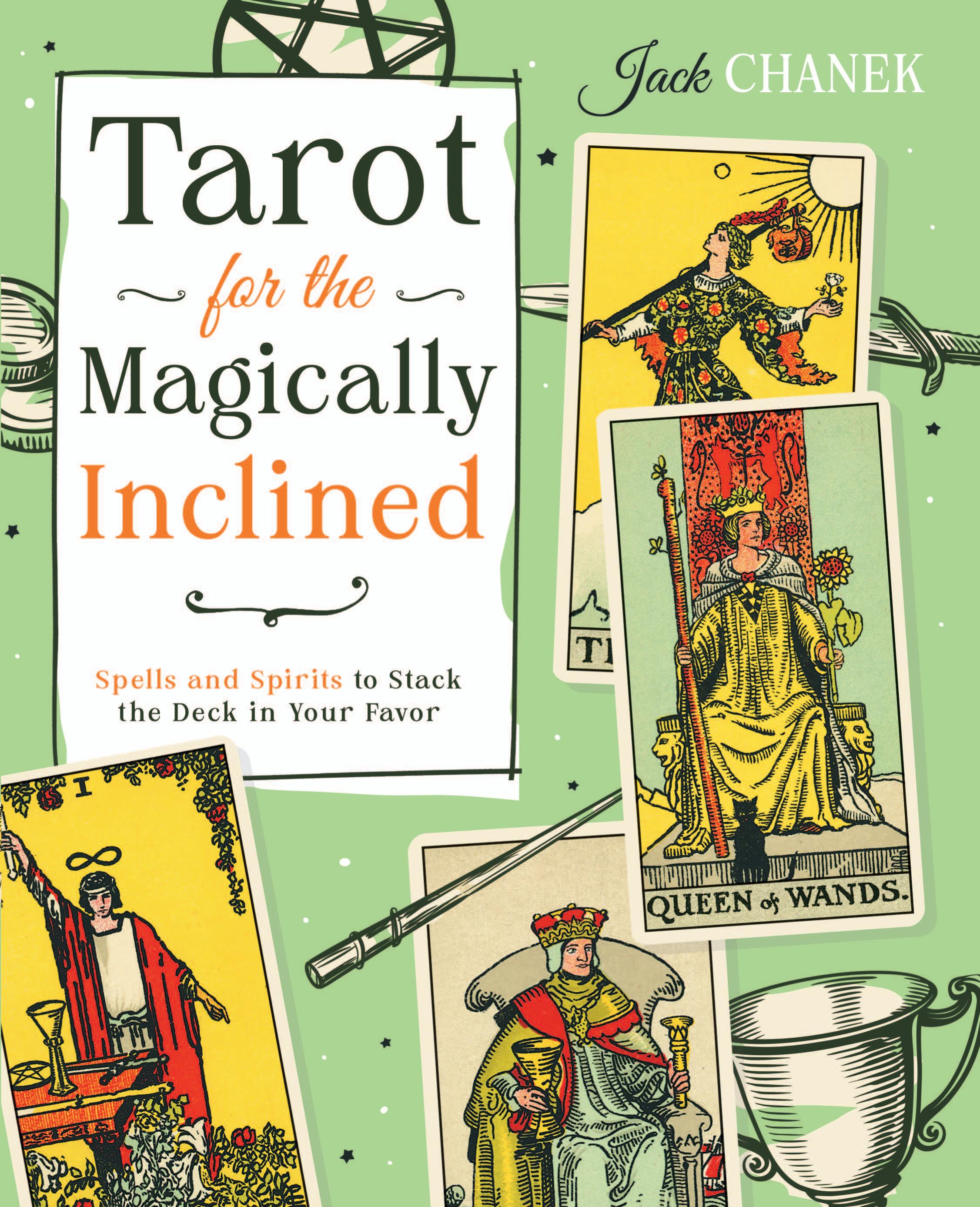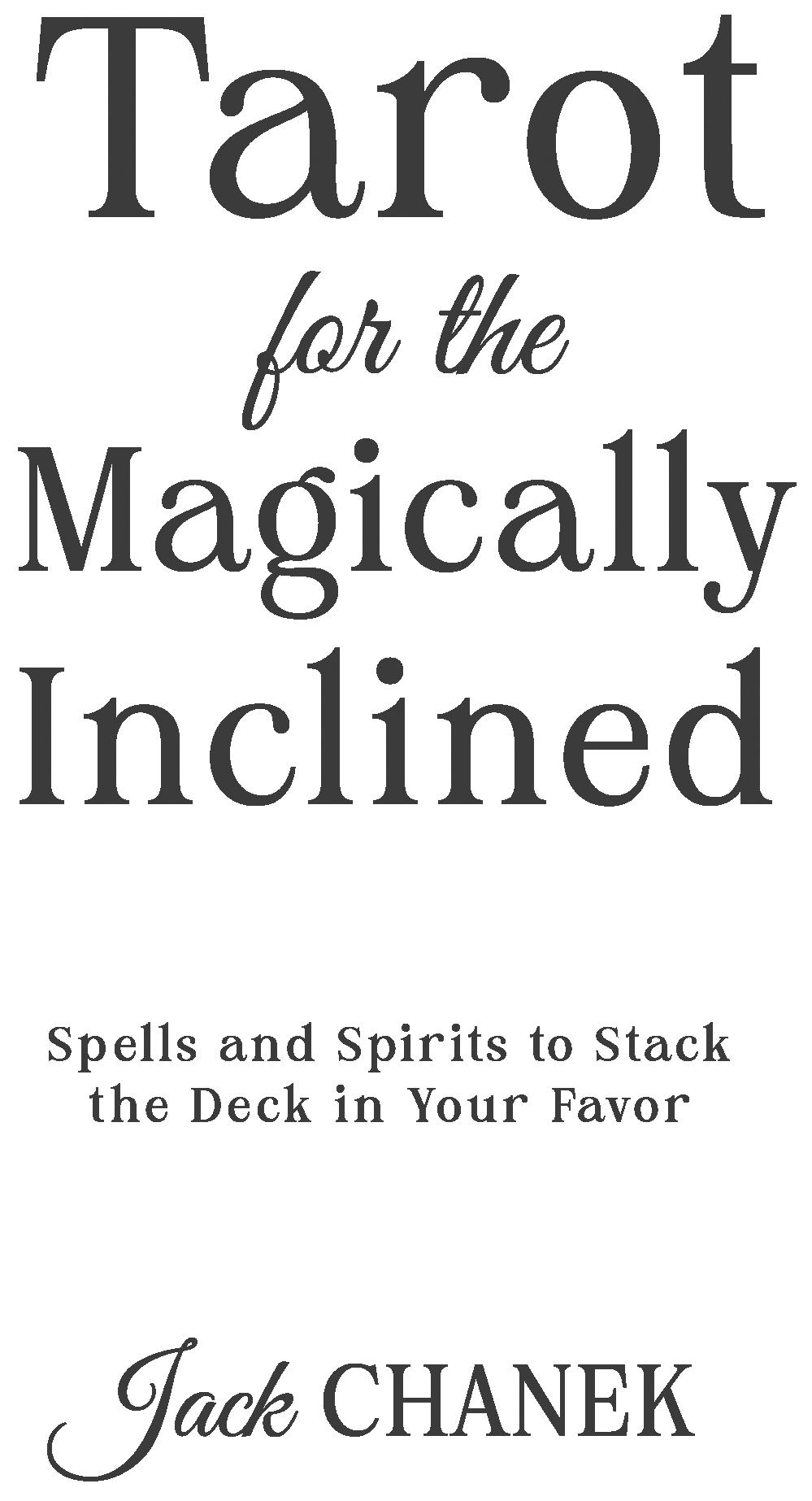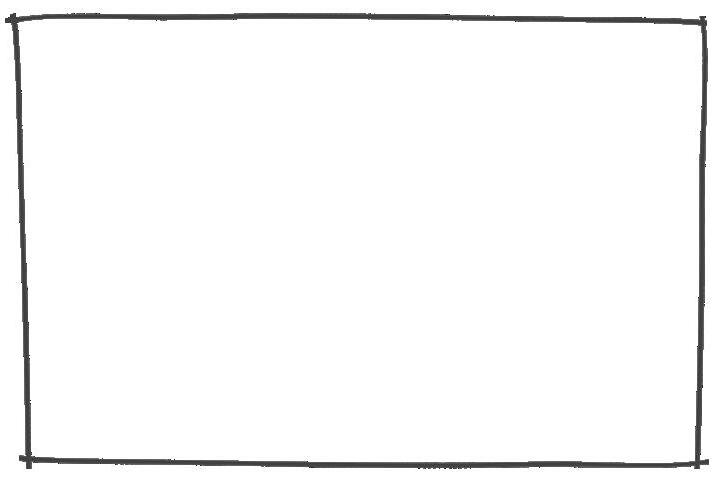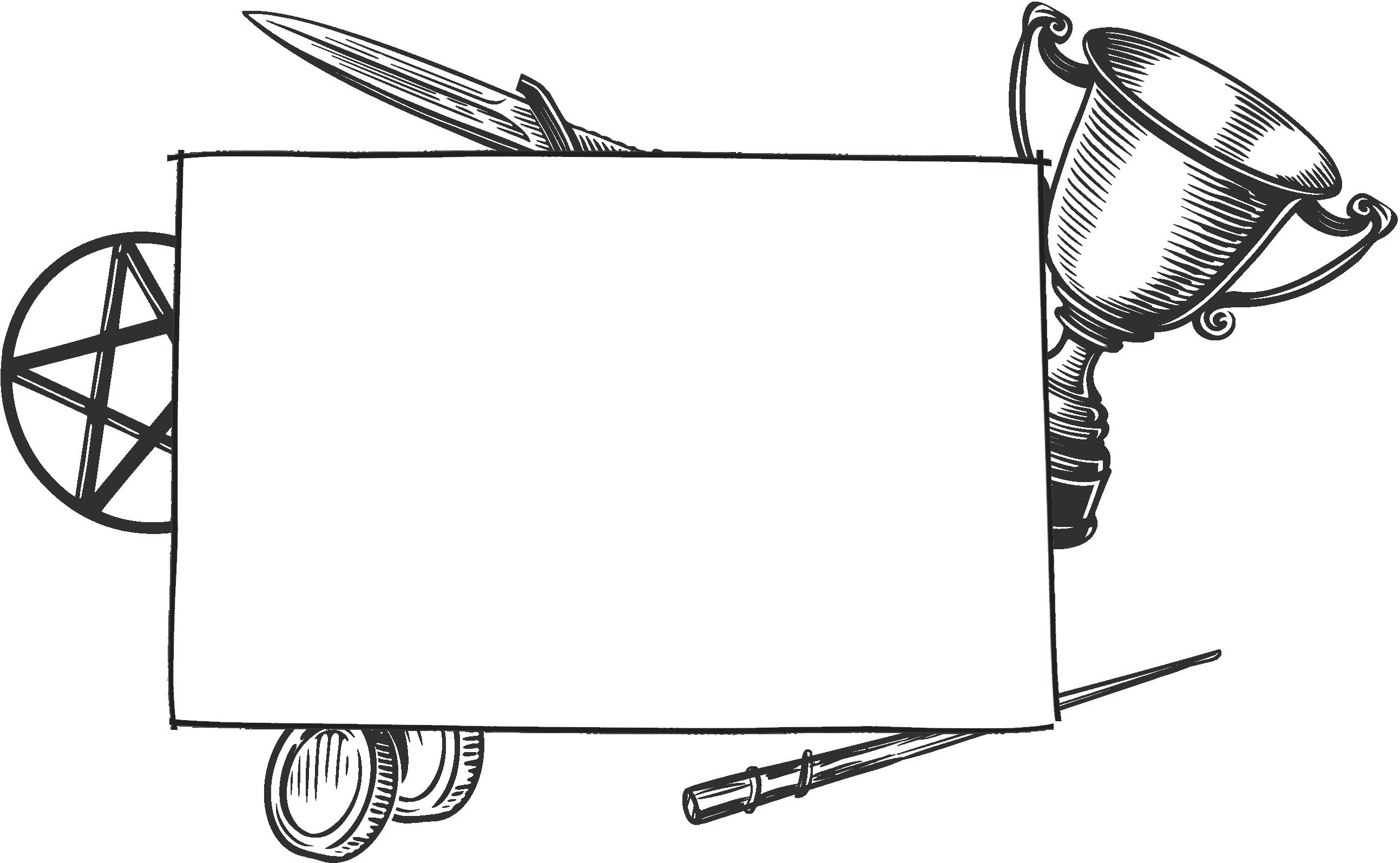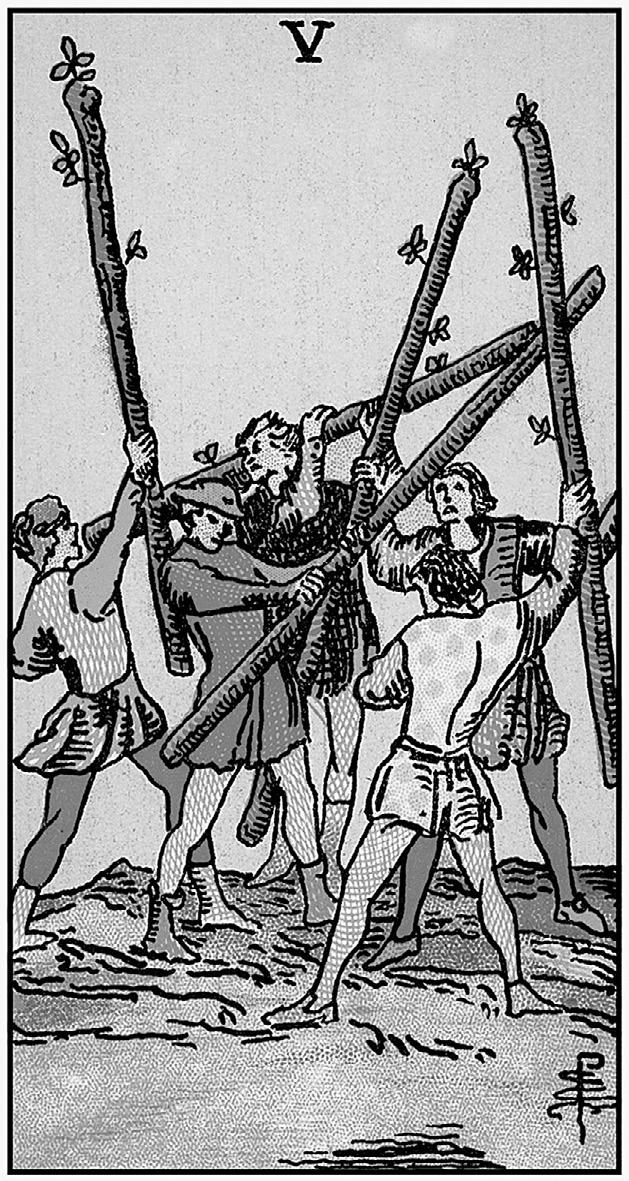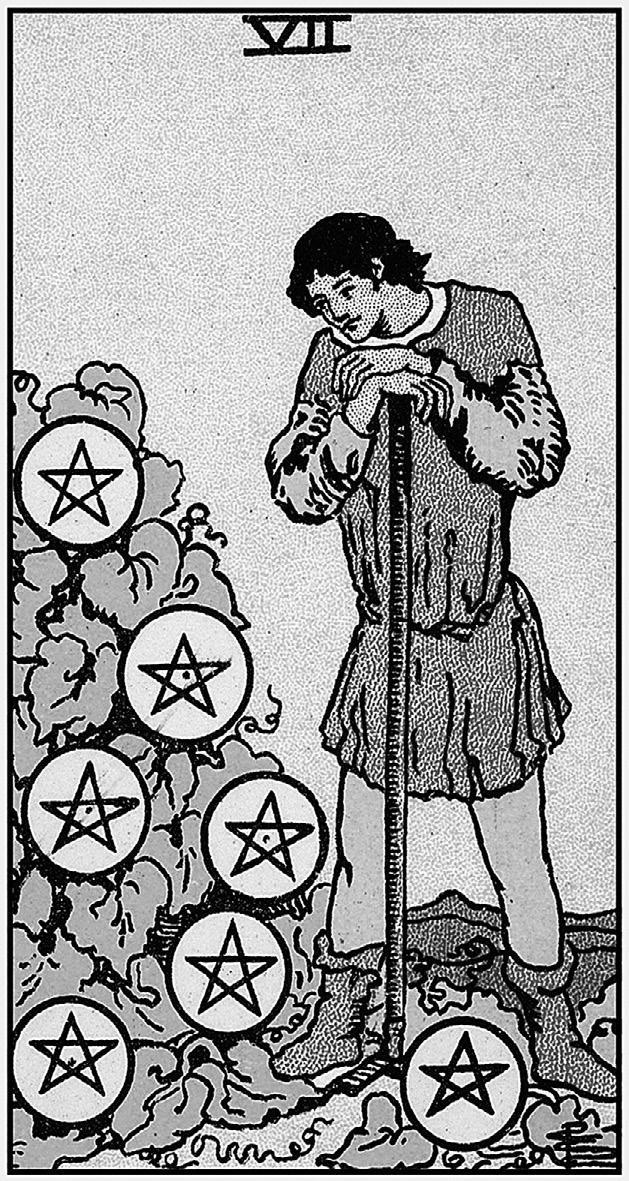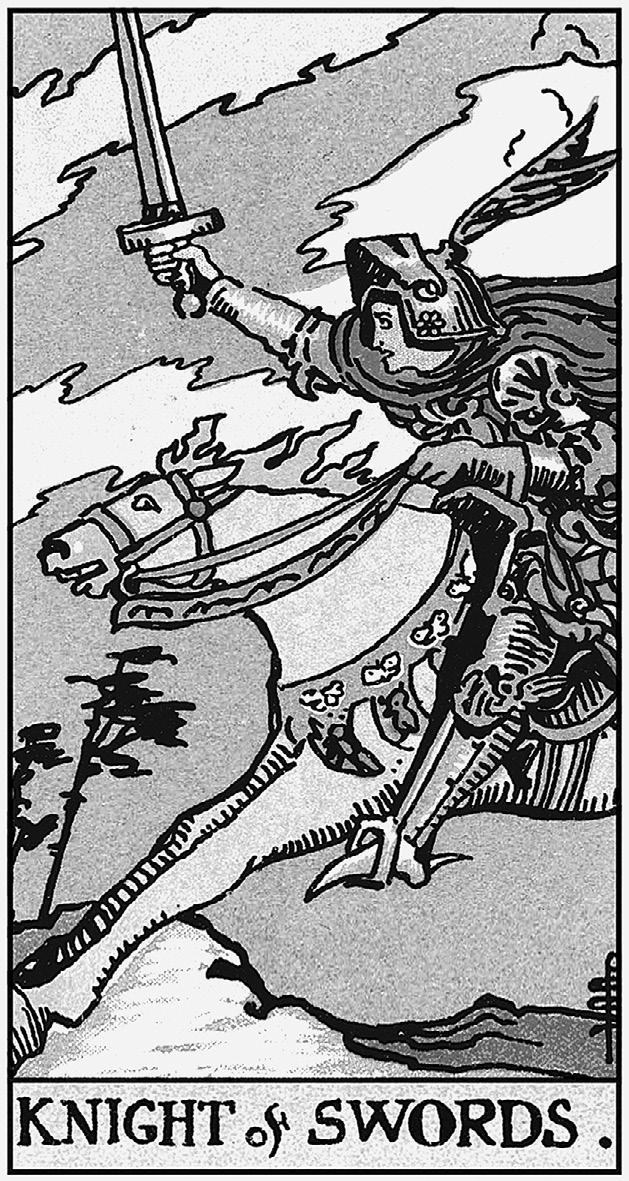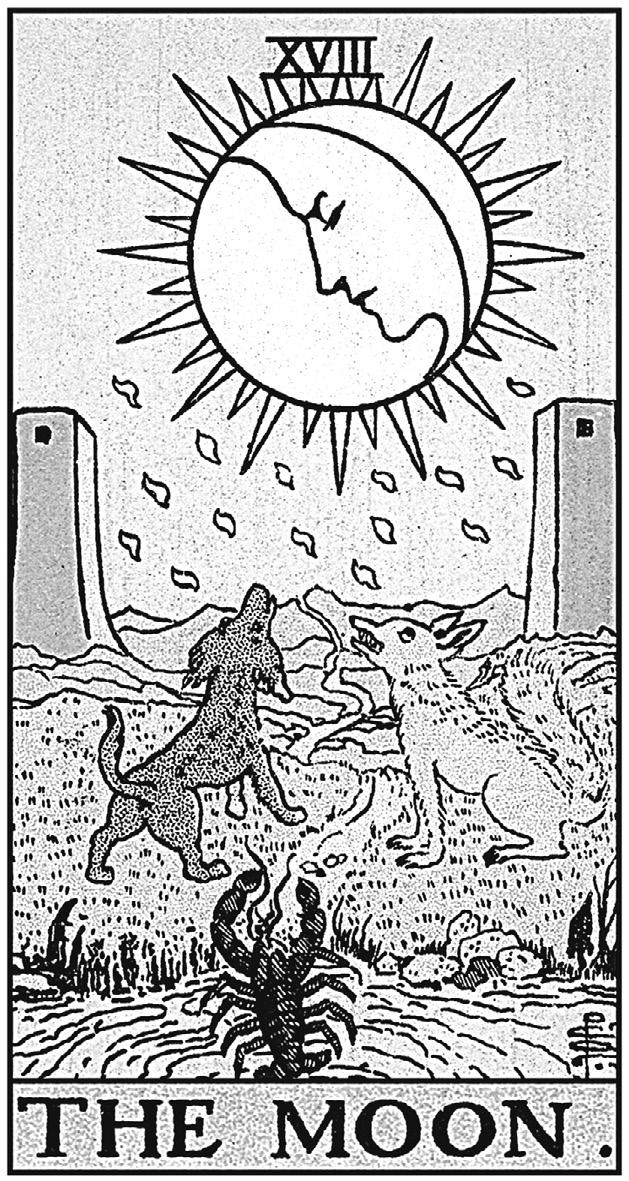About the Author
Jack Chanek is the author of several books on tarot and witchcraft. He is a High Priest of Gardnerian Wicca and has been reading tarot since he was eleven years old. Jack’s work has appeared in The Witches’ Almanac, Studio Magicae, and Aries Witch. His numerous television and podcast appearances include Seeking Witchcraft, Oculus Alchemy, and The Witching Hour with Patti Negri. He has taught workshops on tarot, Wicca, and Qabalah around the country. Jack holds a PhD in the history of philosophy and lives in Salt Lake City, Utah. Visit him at JackOf WandsTarot.wordpress.com.
©
Jen Davis
Tarot for the Magically Inclined: Spells and Spirits to Stack the Deck in Your Favor Copyright © 2025 by Jack Chanek. All rights reserved. No part of this book may be used or reproduced in any manner whatsoever, including internet usage, without written permission from Llewellyn Worldwide Ltd., except in the case of brief quotations embodied in critical articles and reviews. No part of this book may be used or reproduced in any manner for the purpose of training artificial intelligence technologies or systems.
First Edition
First Printing, 2025
Book design by Samantha Peterson
Cover design by Kevin R. Brown
Interior illustrations by Llewellyn Art Department
Tarot Original 1909 Deck © 2021 with art created by Pamela Colman Smith and Arthur Edward Waite. Used with permission of LoScarabeo.
Birth chart on page 84 was created using the Kepler Superb Astrology Program, with kind permission from Cosmic Patterns Software, Inc., the manufacturer of the Kepler program (www.astrosoftware.com, kepler@ astrosoftware.com).
Llewellyn Publications is a registered trademark of Llewellyn Worldwide Ltd.
Library of Congress Cataloging-in-Publication Data (Pending)
ISBN: 978-0-7387-7801-3
Llewellyn Worldwide Ltd. does not participate in, endorse, or have any authority or responsibility concerning private business transactions between our authors and the public.
All mail addressed to the author is forwarded, but the publisher cannot, unless specifically instructed by the author, give out an address or phone number.
Any internet references contained in this work are current at publication time, but the publisher cannot guarantee that a specific location will continue to be maintained. Please refer to the publisher’s website for links to authors’ websites and other sources.
Llewellyn Publications
A Division of Llewellyn Worldwide Ltd. 2143 Wooddale Drive Woodbury, MN 55125-2989 www.llewellyn.com
Printed in the United States of America
Other Books by Jack Chanek
for Wiccans
Qabalah
Queen of All Witcheries
Tarot for Real Life
Featured In Aries Witch
For Deborah, the Hierophant to my Emperor.
Contents
List of Spreads xi
Disclaimer xiii
Introduction: The Hand That Turns the Wheel 1
Part One: A Magical Worldview
Chapter One: A Quick and Dirty Guide to Tarot Reading 9
Chapter Two: What Is Magic? 27
Chapter Three: Earth, Air, Water, and Fire 43
Chapter Four: The Zodiac 59
Chapter Five: The Planets 75
Chapter Six: The Tree of Life 93
Part Two: Tarot in Magic
Chapter Seven: Pathworking and Meditation 119
Chapter Eight: Stacking the Deck 137
Chapter Nine: Tarot Talismans 157
Chapter Ten: Writing Tarot Spells 177
Chapter Eleven: Angels and Demons 195
Chapter Twelve: The Spirits of the Major Arcana 223
Conclusion: The Wheel Keeps Turning 239
Appendix: Keywords and Card Meanings 243
Bibliography 247
List of Spreads
Past/Present/Future Spread 17
Crossroads Spread 18
Celtic Cross Spread 19
Four Elements Spread 48
Zodiac Spread 70
Seven Planets Spread 79
Tree of Life Spread 104
Year Ahead Spread 143
Obstacles and Resources Spread 144
Depth of the Future Spread 145
Growth Spread 146
Connections Spread 146
Course Correction Spread 147
Naming Spread 237
Disclaimer
While best efforts have been used in preparing this book, neither the author nor the publisher shall be held liable or responsible to any person or entity with respect to any loss or damages caused, or alleged to have been caused, directly or indirectly, by the information contained herein. Every situation is different, and the advice and strategies contained in this book may not be suitable for you.
In the following pages you will find recommendations for the use of certain plants and incenses. Each body reacts differently to plants, scents, and other items, so results may vary person to person. If you are allergic to any of the plants or scents suggested in this book, please refrain from use.
Please note that the information in this book is not meant to diagnose, treat, prescribe, or substitute consultation with a licensed healthcare professional. This book is not intended to provide medical advice or to take the place of medical advice and treatment from your personal physician. Readers are advised to consult their doctors or other qualified healthcare professionals regarding the treatment of their medical problems. Neither the publisher nor the author take any responsibility for possible consequences of any person reading or following the information in this book.
introduction The Hand That Turns the Wheel
I want you to think of a tarot card. Any card will do. When you hear the word tarot, what is the first image that comes to your mind?
Most people, when asked to think of a tarot card at random, will pick either Death or the Lovers. These are the two most famous cards in the deck; they have worked so deeply into the popular imagination that their imagery can be found on album covers and tattoos, even hanging in art galleries. If a character in a movie or TV show gets a tarot reading, you can bet good money that they’ll turn up either or both of these cards. In the popular mind, they represent the things that all of us want to know about: sex and death, the mysteries of life, the unknowns that drive us to seek out tarot readings in the first place.
But when I think of tarot, I picture a different card altogether. The card that represents tarot to me is the Wheel of Fortune.
In tarot, the Wheel of Fortune represents the fickle and everchanging nature of life. The Wheel turns, and as it turns it changes the lives of ordinary people, raising some up to new heights and bringing others crashing down. This is a card of pure, blind luck. It’s
unpredictable and uncontrollable. It may bring us the best days of our lives or the worst, but we simply do not know how the Wheel will affect us.
The Wheel of Fortune represents uncertainty about the future and all of the anxieties that come with it. Navigating life can be terrifying when we don’t know what’s coming our way. For many of us, that exact uncertainty is why we turn to tarot. We have questions, doubts, and anxieties; we seek out tarot readings to help provide us with answers, certainty, and security. Tarot is appealing because it shows us the turnings of the Wheel of Fortune, giving us a glimpse of what’s coming our way so that we can prepare ourselves for fate’s caprices. Fortune is mysterious, inscrutable, and terrifying, but tarot allows us to reclaim agency and control.
Tarot is an interpretive art rather than a predictive science, and tarot readers aren’t omniscient. We get things wrong sometimes, and we can’t pull the winning lottery numbers out of a deck of cards. Nonetheless, tarot gives us insight that we wouldn’t otherwise have. It allows us to build a narrative through which to make sense of ourselves and the world around us, to see the major themes in our lives, and to forecast where we’re going based on where we are now. It’s a wonderful tool to understand the turning of the Wheel.
But what if we could use it to do more than just understand? What if we could use it to turn the Wheel of Fortune in our favor?
Tarot is commonly used for prediction or introspection; readers use it to receive and interpret information about the world in a way that’s fundamentally passive. But that’s not its only use. It’s been a tool of divination since at least the eighteenth century, and in that time it has also been used for much more. Readers have associated the seventy-eight cards of a tarot deck with a magical worldview, connecting them to the four elements, the planets and the signs of the Zodiac, and the process of initiation and alchemical transformation. All of this has turned tarot into a magical tool in its own right, one that can be used for meditation, personal growth, and directing future events.
Where divination is passive, magic is active. Magic is about exerting an influence on ourselves or on the world. Around the globe, practitioners from various traditions use magical techniques to attract lovers, improve their finances, process traumas, and much more. People use magic not just to observe the Wheel of Fortune’s turning, but to change it.
Even among tarot readers who don’t practice magic, you’ll find a common refrain: Tarot offers a glimpse of what the future may be, but that future is not immutable. Tarot reading doesn’t consign you to an inevitable fate; rather, it shows you what’s coming your way and equips you to change course if you need to. With tarot, the line between seeing fate and changing fate has always been blurred.
This book is about the intersection of tarot and magic—how magic can inform a tarot reading, and how tarot can be used for magical purposes. I’ll start with a brief introduction to tarot, covering the structure of a deck and the basics of how to perform a reading. Then, I’ll provide a similar introduction to the basics of magic, walking through what magic is, what it can and can’t accomplish, and the fundamentals of how to use it. Together, these chapters will provide you with all the basic knowledge you need in order to use the rest of the book.
The remainder of part I of the book will explore magical perspectives on the tarot deck to show how it fits into a larger magical worldview. Over history, lots of different esoteric correspondences have been overlaid onto the structure of the deck, incorporating tarot into a variety of magical systems. I’ll walk you through some of the most important and widespread correspondences, blending tarot with the four elements, the signs of the Zodiac, the seven classical planets of astrology, and the Qabalistic Tree of Life.
Magical correspondences in tarot are somewhat flexible, and you’ll find variation in how different practitioners map these occult concepts to their tarot decks. For my purposes here, though, I’ll focus primarily on the correspondences used by a nineteenth-century secret society called the Hermetic Order of the Golden Dawn. The Golden Dawn was an incredibly influential organization, running from 1887 to 1903 and leaving an indelible mark on modern magic and modern tarot. Today, many magical groups still practice using the Order’s original rituals and organizational structure. The members of the Golden Dawn tried to connect all of Western occultism in a single unified system of magic—and tarot was one of the key tools they used to produce the symbols and structures of that system. To this day, the divinatory meanings you’ll find listed in most tarot books derive from the magical system of the Golden Dawn, as does classic tarot imagery familiar from decks like the iconic Rider-Waite-Smith tarot. In learning how to view tarot through a magical lens, the Golden Dawn is an excellent place to start.
That does not mean, however, that all of the magic taught in this book will be rehashing the rituals of the Golden Dawn. Quite the contrary, in fact. The Golden Dawn’s magical correspondences are a fantastic point of entry to viewing tarot in a magical way—but once you’ve adopted that magical worldview, the ways you can use tarot in magic are innumerable. In part II of the book, things will get experimental. Taking the foundational knowledge you gained in part I, I’ll share how to incorporate tarot as a magical tool in your rituals and spells, and I’ll do so without adhering to any one system of magic.
Occultism is a big, wide world, and there are lots of different ways to do magic. Some people use magic only for meditation, introspection, and the development of their higher selves. Others use it for concrete, practical results like attracting a lover or finding a job. Some prefer elaborate ceremony with specific robes and tools crafted for each occasion; others lean toward simplicity. In this book, I’ll walk through a little bit of everything so that no matter what your approach to magic is, you can learn how to bring tarot into it.
The magical techniques I share here are my own, based on my personal practice. They’re the result of experiments I’ve performed and innovations I’ve made over my years as a reader and magician. This is important to keep in mind as you work your way through the book: The magic I share in part II is what has worked for me, but I’m only one person. Your magical practice won’t look exactly the same as mine, and as you read this book and try the techniques I offer, you may find yourself wanting to adjust them, expand on them, or try something altogether new. That’s a good thing!
This book is not meant to be the be-all and end-all of tarot and magic; it is, rather, the reflection of one practitioner’s experience, which you can take as a jumping-off point for your own magic. If you try the approaches given here and like them, please use them freely, but don’t feel constrained to do everything exactly as I say. Magic is always at its best when it’s living and dynamic. Don’t be afraid to experiment, to get your hands dirty, and to try new things even if they’re not mentioned in the text. In doing so, you’ll discover far more about the magic of tarot than any book could ever teach you.
Before you dive into reading the book, there is one logistical matter that needs to be taken care of: You’re going to need a tarot deck. For a book about tarot reading and tarot magic, having a deck on hand is essential. In fact, I’d recommend having two decks if you can. You’ll want one deck to use for your readings, but some of the exercises and magical techniques in this book involve using the cards themselves as magical tools, talismans, or ingredients in spellcasting. This means removing cards from the deck and potentially altering them in ways that make them unusable for ordinary reading. So, if you want to have an intact deck to use for divination, it’s a good idea to keep a spare on hand for magical use.
If you don’t want or can’t afford a second deck, that’s not a problem; if a spell or ritual calls for the use of a particular card, you can always print out an image of the card on ordinary paper and use that instead. If you’re artistically inclined, you can draw or paint the image of a card and use that for magical purposes, rather than relying on a deck with someone else’s artwork. Really, as long as you have access to tarot imagery in a way that lets you use it for both reading and magic, you’re good to go.
I’ve been reading tarot since I was a child, and it’s through tarot that I first began to practice magic. My earliest experiments with spellcasting involved using the symbolic language of tarot to express the changes I wanted to see in the world around me, and many of the techniques you’ll find in this book are ones I’ve been using my entire adult life. The language of tarot is one of symbolism, imagery, dreams, and imagination—the same as the language of magic. As such, tarot is already deeply magical. The powers of magic gain expression when we give them voice through reading tarot, and the archetypal images of tarot are made real when we draw them into the world through magic. Tarot and magic have always been connected; this book will teach you to notice that connection and apply it.
Let’s start turning the Wheel of Fortune together.
chapter one A Quick and Dirty Guide to Tarot Reading
This book is, first and foremost, about tarot, so it’s important to start with tarot fundamentals. What is a tarot deck? How does a reading work? Can just anyone read tarot?
Depending on your level of experience, you may already know the answers to these questions. If you’re a seasoned tarot reader, you may have picked up this book looking specifically for information about the connection between tarot and magic. If that’s the case and you don’t want a refresher on tarot fundamentals, you’re more than welcome to skip ahead to chapter 2, where I start talking about magic. If you’re new to tarot, however, or if you want to make sure that my perspective on tarot is not totally alien to your own, this chapter will cover all the basics and make sure we’re on the same page.
Part of tarot reading is personal and intuitive, and it varies from one person to the next; that’s the kind of thing you can’t learn from a book but have to explore through trial and error. Conversely, part of tarot is about having a shared symbolic language through which we can interpret the world around us. Tarot has a structure and an internal logic that help to guide us as readers; if you put the same cards in front of two different readers, they’ll have their own interpretive takes, but they’ll nonetheless pull similar themes to the fore of their readings. I could tell any tarot reader in the world “I did a career reading for someone and drew the Eight of Swords and the Four of Pentacles,” and they would have a sense that my client was feeling
trapped in their career but unwilling to forego financial security. This shared language allows readers to situate themselves in an established framework, to communicate with each other, and to learn from each other. These commonalities—the core that makes tarot what it is—are the subject of this chapter.
How to Perform a Reading
You can read tarot for yourself or for someone else; either way, the process is fundamentally the same. First, the person receiving the reading (called the querent) asks a question. Then, the reader randomly draws a number of cards, identifies those cards’ themes, and fits them to the question that’s been asked. If you ask a question about your new lover and draw cards that are associated with deceit and betrayal, that gives you a very different answer than if you ask the same question and pull cards associated with nurturing and empathy.
The challenging part is knowing how to identify the themes in the cards. Some of this is a matter of consensus, and there is broad agreement among tarot readers about the principal meanings of the cards, although each individual reader will have their own spin on those meanings; the appendix to this book includes a set of basic keywords for all of the cards in the deck. Nevertheless, even if you have a list of keywords on hand, there’s still an intuitive element to tarot reading. You have to figure out how to bridge the gap between the abstract meaning of the cards and the particular details of the question you’ve asked. Ultimately, the only way to learn how to do that is by practice.
If you’ve never done a tarot reading before, it can be a scary prospect to dive in and start reading the cards, but that’s the best way to learn. With that in mind, let’s do a reading together right now. Get your tarot deck, think of a question you’d like the answer to, and shuffle the cards. Then, pull one card at random from the deck. This card is the answer to your question. Don’t look up the “official” meaning of this card just yet. Before you look at what anyone else has to say about the card, take a moment to examine the card closely. What is happening in the image? Are there any people or animals on it? If so, what are they doing? What other details stick out to you? Think about the overall impression that this card gives you. If you had to describe the card with just one word, what word would you use?
This is a lot of information to sift through, but if you can parse all of it, you’ve found the answer to your question. For example, a peaceful, idyllic scene of children playing in a courtyard may speak to you about nostalgia, innocence, and youth; a tempestuous image of a lightningblasted tower may make you think of turmoil and catastrophe. From the visual language of
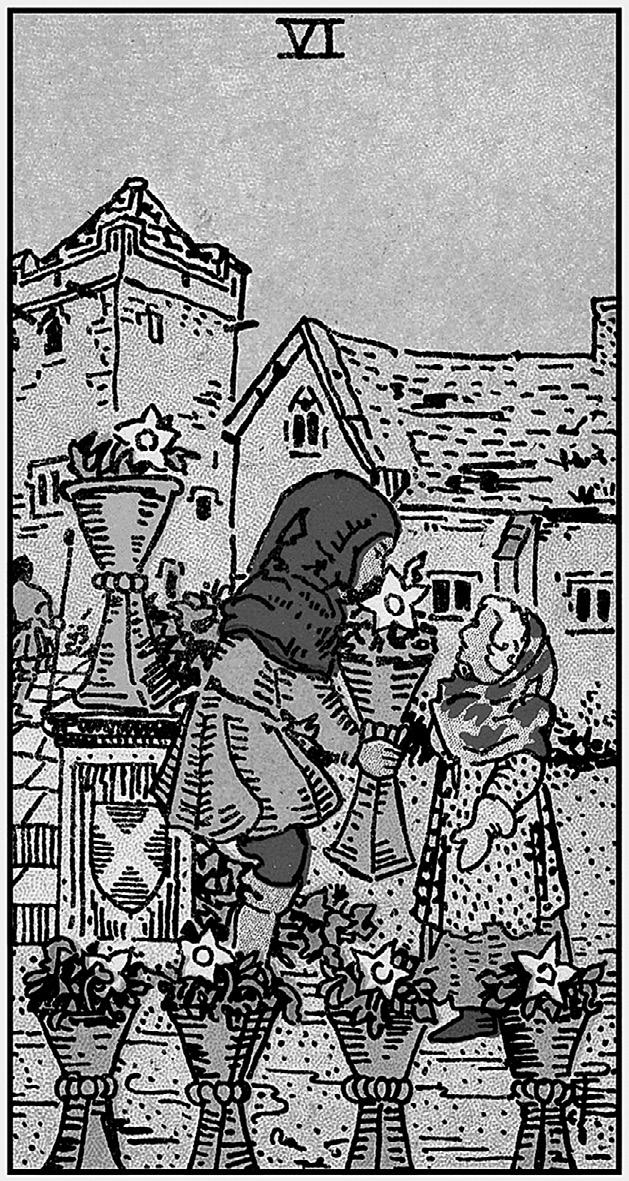

the card, you can extract a thematic core. Then, all that remains is for you to apply that thematic core to your situation. Sometimes, this is easier said than done. If you ask “Where should I go on vacation?” and you draw a card that makes you think of youth, you may be left scratching your head. Surely the reading isn’t suggesting you should spend a week’s vacation working in a kindergarten. But maybe the card is an invitation for you to explore places from your own childhood, favorite summer vacation spots that you haven’t revisited in a long time. Likewise, if you ask “What should I cook for dinner?” and pull a card that looks like catastrophe, the answer to your question probably isn’t “You should cook something terrible.” Instead, it might be an indication that cooking isn’t a good idea tonight; maybe you should consider eating out instead.
After you’ve spent some time examining a card and figuring out what you think it means and how it relates to your question, go ahead and flip to the appendix at the back of this book to see what I’ve said about the card. Think of this not as checking whether your reading was right or wrong, but as adding an extra layer of information. You may have seen something in the card that I don’t see, and that’s okay! The card meanings given in this book aren’t automatically better or more authoritative than the ones you find for yourself, but they can serve as an invitation for you to consider your readings from another perspective, potentially shedding some light on things you wouldn’t otherwise have noticed. Learning how to match cards to your questions takes time. It’s not easy at first, but the more you practice it, the better you’ll get.
Sometimes, you want a more complex and nuanced answer to a question—the kind of answer that you can’t get out of just one card. Once you feel comfortable with one-card readings, try pulling two or three cards at a time. Do the same basic process of examining a card and asking yourself what’s happening in its visual landscape, but now look at multiple cards together. What themes does each card appear to represent on its own? When those themes are brought together, what story do they tell and what is the overall takeaway from them?
The meaning of a card can be significantly influenced by the cards that surround it. Let’s suppose you draw a card that shows several people locked in some kind of tussle. If you place
this card alongside the catastrophic image of a collapsing tower, it would make sense to think of the tussle as something awful and harmful. But if you place the same card next to an idyllic image of childhood innocence, all of a sudden it’s transformed into the kind of play fighting that siblings do, without the dangerous or aggressive undertones it previously had. Reading cards in combination can be a difficult and frustrating process at first. That’s normal, the same way that learning any other new skill is hard. Don’t be discouraged if reading tarot doesn’t come easily to you right away. Just like riding a bike or playing the piano, it’s something that anyone can learn how to do, but it takes a lot of practice, and you will struggle with it when you first start out. Stick with it, practice as much as possible, and—if you’re so inclined—take notes of your readings so that you can revisit them later on and see how much you’ve learned.
The Structure of a Deck
A tarot deck is typically composed of seventy-eight cards, although some decks might have an extra card or two added into the mix. Each of these seventy-eight cards has a particular set of themes or ideas that are associated with it. These themes aren’t haphazardly assigned; they are, rather, the product of the deck’s internal structure. The seventy-eight cards of a tarot deck are divided into a number of smaller groups, each of which is associated with a particular range of themes. Looking at these smaller groups and the ways in which they overlap, we can begin to get a sense of individual card meanings and how they fit into a larger whole.
Major and Minor Arcana
The first division of the deck is between the so-called Major Arcana (Latin for “greater mysteries”) and the Minor Arcana (“lesser mysteries”). The Major Arcana are a set of twenty-two trump cards that are more or less separate from the rest of the deck. These are the cards most people picture when they think of tarot: the ones with titles like Death or the Lovers. As befits their name, the Major Arcana represent the big, universal themes of human life, the moments of significant transformation that we all go through. Their themes capture things like fate, initiation, suffering, renewal, and completion. By contrast, the Minor Arcana represent smaller, more everyday themes—not an archetype like fate, but something quotidian like jealousy, friendship, or hard work.
Each of the Major Arcana is assigned a number in sequence from zero to twenty-one. Individual decks might have some variation in the names of these cards and the order in which they’re given, depending on the preferences of the deck creator. That said, there’s a fairly standard order you’ll find in most commercially available tarot decks:1
0. The Fool
I. The Magician
II. The High Priestess
III. The Empress
IV. The Emperor
V. The Hierophant
VI. The Lovers
VII. The Chariot
VIII. Strength
IX. The Hermit
X. Wheel of Fortune
XI. Justice
XII. The Hanged Man
XIII. Death
1. One of the most common variations is for cards 8 and 11—Strength and Justice—to be swapped so that Justice is number 8 in the sequence and Strength is number 11.
XIV. Temperance
XV. The Devil
XVI. The Tower
XVII. The Star
XVIII. The Moon
XIX. The Sun
XX. Judgement
XXI. The World
Both the Major and Minor Arcana represent important themes in human life, and they’ll both show up in tarot reading, but these themes are on different scales. The Minor Arcana reflect the situations we encounter in our day-to-day lives, whereas the Major Arcana are bigger and more dramatic. They mark the places where the road forks before us and our lives are permanently changed.
The Four Suits
Setting aside the twenty-two Major Arcana, there are fifty-six Minor Arcana remaining in the deck. These are divided into four suits of fourteen cards each. As with the Major Arcana, you’ll find a little bit of variation in how these suits are named from one deck to another, but the most common names for the suits are Pentacles, Swords, Cups, and Wands. Each of these suits, in turn, is associated with a particular range of themes.
• Pentacles are material. They’re associated with health, work, money, the home, and security.
• Swords are rational. They’re connected to thinking, writing, speaking, analysis, and intellect.
• Cups are emotional. They’re linked to intuition, feeling, relationships, family, and spirituality.
• Wands are appetitive. They deal with themes of passion, sexuality, anger, desire, and willpower.
These themes affect the meanings of individual cards in each suit; for example, the Ace of Cups deals with an overflowing of emotion, whereas the Ace of Pentacles typically represents a material investment. But beyond individual card meanings, they also affect the balance of a reading as a whole. If you draw multiple cards in a reading, the balance of the suits tells you something about the situation at hand. A preponderance of Swords tells you that you might be overthinking things, too many Wands might indicate that you need to let your temper cool off, and so on. The suits of the Minor Arcana can help you draw connections between cards in a reading, knitting together individual cards to form a single, cohesive answer to your question.
The Pips
Each suit of the Minor Arcana is further subdivided into a set of ten numbered cards (often called the pips) and four face cards (called the court cards). The pips are numbered Ace through Ten, like the number cards in a poker deck. Each number in tarot carries its own range of thematic meanings; there is something that all of the Aces have in common, that all of the Twos have in common, and so on up through the Tens. Each tarot reader develops their own sense of the numerological meanings of the pip cards, and no two readers see the numbers exactly the same way. My own understanding of the pip cards is as follows:
• Aces are beginnings and potential.
• Twos are duality and reciprocity.
• Threes are dynamism and change.
• Fours are stability and foundation.
• Fives are hardship and strife.
• Sixes are equilibrium and reevaluation.
• Sevens are perspective and intention.
• Eights are freedom and motion.
• Nines are fulfillment and culmination.
• Tens are consequences and endings.
These meanings combine with the meanings of the suits to help indicate the significance of individual cards. For example, the Two of Cups is about duality and reciprocity in the context of emotions and relationships; consequently, this card typically represents partnership, such as
a romance or a strong friendship. The Six of Swords is equilibrium and reevaluation in the context of thought and rationality; it represents scientific inquiry, inquisitiveness, and changing your mind. Individual card meanings aren’t just a combination of number plus suit—there is often additional nuance to them above and beyond the correspondences listed here. Nonetheless, the significance of a card’s number and suit always bring to bear on its meaning.
Moreover, as with the other categories we’ve explored, you can look at numbers not just with individual cards, but in the balance of your reading as a whole. If you draw all the Threes in a reading, that tells you that something in your querent’s situation is changing rapidly. If your reading is heavy on Sevens, that might be an invitation for your querent to introspect and evaluate their own perspectives. Looking at these structural elements can help you gain a sense of a tarot reading as a larger, interconnected unity, rather than just stringing together a series of isolated card interpretations.
The Court Cards
Each suit of the Minor Arcana has fourteen cards, but the pips only run from Ace through Ten. The remaining four cards are face cards, known in tarot as the court cards. These cards are typically titled the Page, Knight, Queen, and King. The court cards represent people and personalities—and as such, they can be some of the most difficult cards in the deck to understand, because people are messy and complicated. As a starting point for understanding these cards, think about the four roles they represent and the functions they fulfill in the context of a medieval court:
• Pages are obeisant. They carry messages or act at someone else’s behest.
• Knights are engaged. They intervene directly and take action to accomplish their goals.
• Queens are persuasive. They win other people over to their point of view.
• Kings are powerful. They wield explicit authority and command others.
The court cards often represent people who are involved in the situation you’re reading about, including the querent’s friends, foes, or even the querent themself. Thus, a King might represent someone’s boss, whereas a Knight would be a colleague or competitor. These roles combine with the four suits to give more specific personality profiles: The Queen of Swords persuades people by appealing to reason, whereas the Queen of Pentacles makes people feel safe and secure.
If a reading doesn’t include many court cards, then the querent is able to act independently in their situation. If, on the other hand, your reading is cluttered with the courts, this indicates
that the querent’s situation is one that involves a lot of other people, for good or for ill. These people might be working to the querent’s benefit or detriment, but either way, their influence should not be ignored.
Reading with Spreads
If you’re performing a reading with multiple cards, it can be unclear how to organize all the information you receive. If you’re trying to decide between two romantic prospects and you draw the Queen of Cups and the Queen of Wands, how do you know which card represents which person? If you’re doing a reading about your career trajectory and you pull the Eight of Pentacles, does that show where you’re heading or where you’ve already been?
In order to help provide some structure to their work, many tarot readers like to employ formalized card layouts known as spreads. A tarot spread is a fixed number of cards arranged in a particular way; each position in the spread is assigned a particular area of inquiry answered by the card placed there. In this way, you can take a fairly complicated question and break it down into smaller, more manageable pieces. Rather than trying to answer the whole question all at once, you identify its component parts, answer each of those, and then bring your smaller answers together to provide a holistic answer to the question as a whole.
Not all tarot readers use spreads. Some readers feel like spreads are too rigid, because they box in the meanings of the cards and force you to interpret each card a certain way; these readers prefer a free flow where they can intuitively identify how the cards relate to each of the myriad components of the question at hand. Whether you use spreads or not is largely a matter of personal preference; I myself go both ways depending on the circumstances and my mood. For beginners, I do recommend starting out by reading with spreads, because the additional structure can help you make sense of what might otherwise be an overwhelming amount of information. You can always stop using the technique if you end up disliking it, but as with most things, I think there’s value in giving it a fair shot.
Past/Present/Future Spread
The most common spread you’ll encounter is a simple three-card reading, with the cards arranged in a horizontal line. These cards are interpreted in chronological order: The leftmost card is the past, the central card is the present, and the rightmost card is the future. Reading the cards in this way gives you a sense of progression and development. Rather than just giving you a snapshot answer of what your situation looks like in the present moment, this spread shows you where you’ve been and where you’re heading if you stay on your current path.
1. The past
2. The present
3. The future
Already, this spread gives you a great deal more context than a one-card reading, and potentially more than an unstructured three-card reading as well. It shows you how your situation is changing over time, how your present circumstances result from the past, and what the likely outcome is going to be.
Consider this example. If you ask “Does he love me?” and you draw only one card, in which you see stagnation and boredom, you might think the answer is no. But now suppose that you draw three cards: In the center is the card of stagnation, but on the left is a card of infatuation, and on the right is a card of new beginnings. Here, we get a more robust and nuanced answer to the question: In the past, he loved you deeply, but things are stagnating right now. All hope is not lost, though, if you can find a way to rekindle the spark of passion going forward.
Crossroads Spread
A slightly more complex spread adapts this same chronological structure and adds a vertical element to it. Place a card in the center of your reading. Then, place a second card on top of it, rotating this card 90 degrees so that it’s horizontal. The two cards together form an equalarmed cross. Place cards to the left and right of this central cross, and then place two more cards: one below it and one above. The result should look something like a crossroads.
1. The present
2. The problem
3. The past
4. The future
5. The root cause
6. Advice
This spread gives you the same basic chronological structure that the three-card Past/Present/Future spread does. However, it adds a layer of depth: Instead of just showing you what happens across time, it shows you why. The horizontal axis of the spread is chronological, but the vertical axis is analytical. It shows you the problem at hand, the hidden root cause of that problem, and overall advice on how best to deal with the problem. This spread shows you the intersection of what and why in a way that doesn’t just describe your situation; it equips you to act on it and—if need be—to change it for the better.
Celtic Cross Spread
The third spread we’ll discuss here (and the last one for this chapter) is one of the most famous spreads in tarot. It’s known as the Celtic Cross. If you’ve ever seen a tarot reading on TV or in a movie, it’s likely that this was the spread being used; likewise, if your tarot deck came with a companion book that describes how to read with spreads, there’s a good chance this is included among them. There are a number of minor variations on the Celtic Cross spread, but the following is the one I use.
Deal out six cards exactly as you did in the Crossroads spread. Then deal four more cards to the right of them, in a vertical line starting from the bottom.
1. The present
2. The problem
3. The past
4. The future
5. The root cause
6. Advice
7. Self-perception
8. External influences
9. Hopes and fears
10. The long-term outcome
The first six cards are interpreted the same as in the Crossroads spread. The final four cards give further insight into the influences at play. At the bottom of the line, there’s a card representing the querent’s self-image and self-perception. The next card up represents other people
A Quick and Dirty Guide to Tarot Reading 21
or external influences affecting the querent’s situation. Above that is a card for the querent’s hopes or fears, which are often two sides of the same coin. And finally, at the very top of the stack, there is a card forecasting the long-term outcome of the situation, looking even further afield than the Future card in position 4.
The Celtic Cross is a bit of a difficult spread to work with. I find that for most questions, I don’t actually need all the information the Celtic Cross provides; I’m often better off with the narrower scope of something like the Past/Present/Future or Crossroads spreads. But if you really want to get an in-depth understanding of an issue—and particularly if you want psychological insight into how the querent is perceiving and reacting to the problem they face—the Celtic Cross is a useful spread to have in your back pocket.
Targeted Spreads
You’ll have the opportunity to explore more spreads over the course of the book, but these three are a good set to get you started. There are countless tarot spreads available, and new ones are always being created. Some spreads, like the three I’ve shared here, are all-purpose: They’re designed to give you useful information about any question you ask. Other spreads are designed for more specific use.
Depending on the question you’re asking, you may want to use a spread that’s tailored to give you specific insights. Decision-making spreads, for example, are usually structured in two parts: one looking at option A and one looking at option B. Readings about romance and relationships will typically use spreads that have cards devoted to each of the partners involved. The information you need in a reading often depends on the question being asked, so it makes sense to use a spread that’s sensitive to a particular question rather than a catch-all.
Additionally, some spreads are designed with a particular theme in mind. This theme might be visual—there are spreads shaped like hearts, smiley faces, Christmas trees, and more—or it might be more abstract. In my time as a tarot reader, I’ve used spreads taking inspiration from the months of the year, the archetype of the Hero’s Journey, occult concepts, and even famous nursery rhymes. Just about any means of organizing information can be turned into a spread, and sometimes you’ll find that a particular organizational structure is exactly what you need for a given reading.
You can also come up with your own spreads. This is intimidating at first, but it’s an easy skill to pick up. If you’re faced with a question and can’t find a spread that you feel adequately answers it, think about what information you really want out of your reading. What do you need to know in order to answer your question? How can you break that down into its component parts? Write
those parts in a list, then design a spread assigning one card to each of the parts you’ve identified. Voilà! Your very own custom-made tarot spread.
Reading with Reversals
Depending on how you shuffle and lay out your cards, you may find that you deal some cards upside-down. These are known as reversals. Some tarot readers ignore reversals, simply flipping each card to an upright orientation as they draw it. However, other readers like to interpret an additional layer of meaning with reversed cards.
There are a variety of ways that people choose to interpret reversals. Reversals don’t feature heavily in the magic I’ll be discussing in this book, so I won’t go into too much depth here, but I’ve provided a brief survey of a few principal approaches you might find.
Weakened Meaning
Some readers see a reversed card as being weaker than it would be if it were upright; it still carries the same basic energy, but it’s somehow moderated or tempered. So, if the Nine of Cups represents exuberant joy when it’s upright, you might interpret the reversed Nine of Cups as still signifying happiness, but maybe not the same level of exultant bliss. In a similar vein to this, reversals might represent obstacles or delays; the energy of the card is present, but something is getting in its way and slowing it down.
Opposite Meaning
A second approach is to think of a reversed card as the mirror image of its upright meaning. If an upright card means charity, its reversal might mean selfishness; if the upright card means stagnation, the reversal might mean growth. This approach is less suited to the more dramatic, extreme cards in the deck; it’s very hard to look at an image of chaotic destruction and say “This would normally mean catastrophe, but since the card is upside-down, the blood and flames actually represent everything working out perfectly.”
Nonetheless, some cards have twin meanings that can be two sides of the same coin, and in those instances, reversals can help you discern between two distinct but related themes. There’s a deep connection between giving and taking, between indecision and action—and these contradictory things often show up as meanings for the same card. In tricky cases, a reversal can point you to one of these surprising and seemingly contradictory themes.
Negative Meaning
A third approach to reversals is to interpret every card as a negative, harmful, or bad version of its upright self. If the Ten of Wands represents hard work, its reversal is toil without reward; if the Hierophant represents authority and tradition, its reversal is dogmatism and zealotry. Personally, I don’t care for this approach to reversals, because I think it skews readings and makes them too negative. After all, not every card in the deck is cheerful even when they’re upright. Interpreting every reversed card negatively adds seventy-eight more bad omens into the mix, and it means a sizable majority of readings would come out negative. To me, at least, that doesn’t seem like an accurate reflection of reality, and I think it puts the reader at a disadvantage when trying to give a faithful reading.
That’s not to say that reversals never mean something negative—I’ve certainly come across readings where they did. However, I’m leery of casting my net too wide, and I think it’s a misstep to start thinking that every reversal must simply be a worse version of the upright card.
Intuition and Reversals
Reading with reversals—like all tarot reading—ultimately relies a great deal on your intuition. If you choose to include reversals in your readings, you have to determine on a case-by-case basis what each reversal means. The approaches shared here are useful guidelines to help you make that determination, but there is no formula that can cleanly convert an upright card meaning into a reversed one. You have to trust your gut and look at the context of the reading in order to find the interpretation that best fits with the question you’ve asked and the other cards you’ve drawn.
One general rule that I find helpful is to think of a reversed card as saying “Yes, but…” The original meaning of the card is still present somehow—a reversal isn’t completely disconnected from the upright card—but there’s a caveat. The reversal indicates that you want to take a closer look at what the card is doing, because not everything is as it seems. If you draw the Eight of Cups reversed, you can say, “This card normally deals with themes of disengagement or abandonment, but that’s not the whole story in this case.” Your job as the reader, then, is to figure out the “but.”
Interactions Between Cards
When you lay out multiple cards for a reading, regardless of whether you’re using a designated spread or something more freeform, it’s important not to fall into the trap of looking at each card in isolation and neglecting the larger reading. The cards are working together to tell a
Chapter One
cohesive story, and each part of that story contributes to the larger whole. It’s good and useful to look at each card’s individual meaning, but you also want to take a step back and look at the big picture. Try not to miss the forest for the trees.
One of the best ways to do this is to look at the visual connections between the cards in your reading. Imagine these cards not as a set of unrelated images stacked side by side, but as parts of a single, cohesive painting. What does that painting look like? What’s happening in it? Who are the characters depicted?
Take a particular look at the people depicted in your deck. Is anyone facing toward another card? Consider their body language and what it looks like they’re doing. Are they speaking? Reaching out a hand to help? Charging into battle? Now, think about what they’re facing toward. If they’re going to battle, what are they battling against? If they’re offering help, who is the recipient?
This visual dynamic can tell you a great deal about how the energies of different cards interact. When the Knight of Swords charges away from the dreamy Moon and toward the practical Seven of Pentacles, he’s on a mission to stop fantasizing and start getting things done. If he’s going in the other direction, however, his task is completely reversed; now, he has decided to stop holding himself back and allow himself to dream bigger. Together, the cards tell a visual story that would be lost if you just looked at each one by itself.
When you evaluate your reading as a whole, rather than just as a series of disconnected parts, make sure that you also look for shared symbols across the cards. Are there any cards that share particular images? What do those images make you think of? These repeated motifs can indicate obscure connections and can help you pay attention to themes that might not otherwise be obvious. If you see a butterfly on several cards in your reading, for example, you might start to think about transformation and rebirth as a core theme for the reading. Then, you can see which cards contribute to the theme of transformation by identifying which ones feature the butterfly imagery.
Learn by Doing
This chapter has offered a very quick rundown of the fundamental skills involved in reading tarot. There is a great deal more to discuss, but space is limited, and this book isn’t just about how to read tarot—it’s about how to use tarot for magic. Hopefully, this is enough to give you at least a basic grasp of the skills involved in tarot reading so that you can continue to develop those skills as you explore the magical themes and techniques presented in the rest of this book.
The most important advice I have for learning how to read tarot is that you have to practice. Tarot is a skill like any other; you’ll only get good at it through lots and lots of practice. Just like learning to play the piano, you’ll be clunky and mechanical at first, but the more time you put in, the better you’ll get at it. Try to perform a tarot reading every day, even if it’s just on a small, simple question. This is like running scales on the piano: It keeps you engaged, gives you an opportunity to apply the skills you’ve learned so far, and lets you push yourself a little bit more
each time. Eventually, you’ll find that you’re comfortable with the fundamental skills, so much so that you don’t have to consciously think about the basic steps of tarot interpretation. From there, you can push yourself further, learning more advanced techniques. You’ll be performing complex readings—or playing elaborate sonatas—sooner than you know.
